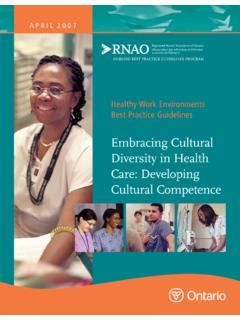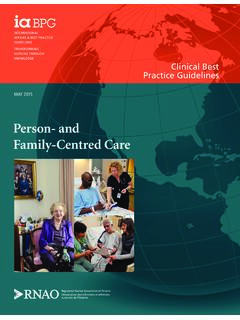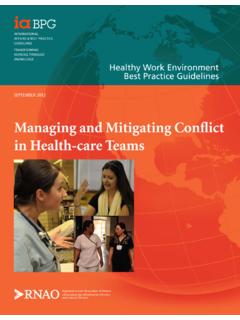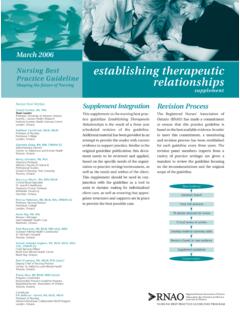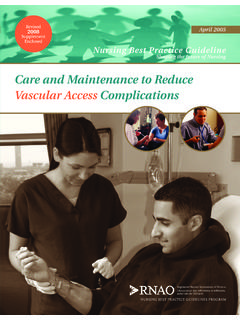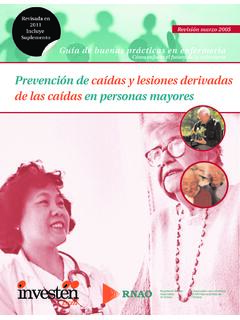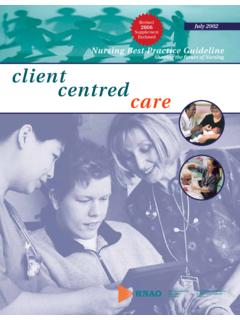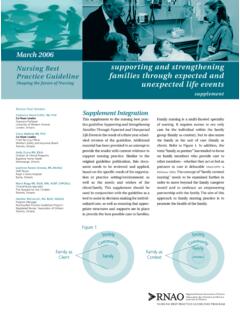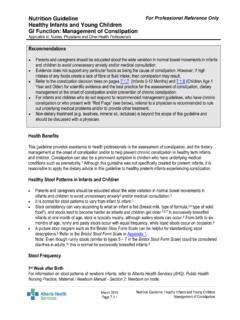Transcription of Breast Feeding - RNAO
1 Best Practice Guideline JULY 2018. Breastfeeding - Promoting and Supporting the Initiation, Exclusivity, and Continuation of Breastfeeding for Newborns, Infants, and Young Children Third Edition Disclaimer These guidelines are not binding on nurses or the organizations that employ them. The use of these guidelines should be flexible and based on individual needs and local circumstances. They constitute neither a liability nor discharge from liability. While every effort has been made to ensure the accuracy of the contents at the time of publication, neither the authors nor the Registered Nurses' Association of Ontario (RNAO) gives any guarantee as to the accuracy of the information contained in them or accepts any liability with respect to loss, damage, injury, or expense arising from any such errors or omission in the contents of this work.
2 Copyright With the exception of those portions of this document for which a specific prohibition or limitation against copying appears, the balance of this document may be produced, reproduced, and published in its entirety, without modification, in any form, including in electronic form, for educational or non-commercial purposes. Should any adaptation of the material be required for any reason, written permission must be obtained from RNAO. Appropriate credit or citation must appear on all copied materials as follows: Registered Nurses' Association of Ontario. Breastfeeding - Promoting and Supporting the Initiation, Exclusivity, and Continuation of Breastfeeding for Newborns, Infants, and Young Children.
3 3rd ed. Toronto (ON): Registered Nurses'. Association of Ontario; 2018. Funding This work is funded by the Ontario Ministry of Health and Long-Term Care. All work produced by RNAO is editorially independent from its funding source. Contact Information Registered Nurses' Association of Ontario 158 Pearl Street, Toronto, Ontario M5H 1L3. Website: Breastfeeding - Promoting and Supporting the Initiation, Exclusivity, and Continuation of Breastfeeding for Newborns, Infants, and Young Children Third Edition Breastfeeding - Promoting and Supporting the Initiation, Exclusivity, and Continuation of Breastfeeding for Newborns, Infants, and Young Children Greetings from Doris Grinspun, Chief Executive Officer, Registered Nurses' Association of Ontario The Registered Nurses' Association of Ontario (RNAO)
4 Is delighted to present the third edition of the clinical best practice guideline Breastfeeding - Promoting and Supporting the Initiation, Exclusivity, and Continuation of Breastfeeding for Newborns, Infants, and Young Children. Evidence-based practice supports the excellence in service that health professionals are committed to delivering every day. We offer our heartfelt thanks to the many stakeholders who are making our vision for best practice guidelines a reality, starting with the Government of Ontario, for recognizing RNAO's ability to lead the program and for providing multi- year funding.
5 For their invaluable expertise and stewardship of this Guideline, I wish to thank the co-chairs Dr. Cindy-Lee Dennis (Professor in Nursing and Medicine, University of Toronto) and Dr. Sonia Semenic (Associate Professor, McGill University). Thanks to RNAO. staff Katherine Wallace (Guideline Development Lead), Glynis Gittens (Project Coordinator), Zainab Lulat (Lead Nursing Research Associate), Giulia Zucal (Nursing Research Associate), Dr. Lucia Costantini, (Associate Director of Guideline Development, Research and Evaluation), and the rest of the RNAO Best Practice guidelines Research and Development Team for their intense work in the production of this Guideline.
6 Special thanks to the members of the RNAO expert panel for generously providing their time and expertise to deliver a rigorous and robust clinical resource. We couldn't have done it without you! Successful uptake of best practice guidelines requires a concerted effort from educators, clinicians, employers, policy-makers, and researchers. The nursing and health-care community, with their unwavering commitment and passion for excellence in patient care, have provided the expertise and countless hours of volunteer work essential to the development and revision of each best practice guideline.
7 Employers have responded enthusiastically by nominating best practice champions, implementing guidelines , and evaluating their impact on patients and organizations. Governments at home and abroad have joined in this journey. Together, we are building a culture of evidence-based practice. We invite you to share this Guideline with your colleagues from other professions and with the patient advisors who are partnering within organizations because we have so much to learn from one another. Together, we must ensure that the public receives the best possible care every time they come in contact with us making them the real winners in this important effort!
8 Doris Grinspun, RN, MSN, PhD, LLD (Hon), Dr (hc), O. ONT. Chief Executive Officer Registered Nurses' Association of Ontario 2 REGISTERED NURSES' ASSOCIATION OF ONTARIO. Breastfeeding - Promoting and Supporting the Initiation, Exclusivity, and Continuation of Breastfeeding for Newborns, Infants, and Young Children Table of Contents Abbreviations Used in This Best Practice Guideline.. 5. How to Use This Document .. 8. Purpose and Scope .. 9. Interpretation of Evidence.. 16. BACKGROUND. Quality of Evidence .. 17. Summary of Recommendations.. 18. RNAO Best Practice Guideline Research and Development Team.
9 21. RNAO Expert Panel .. 22. Stakeholder Acknowledgment.. 24. Background Context .. 29. Practice Recommendations.. 33. Education Recommendations .. 88. R E C O M M E N D AT I O N S. Organization and System Policy Recommendations .. 91. Research Gaps and Future Implications .. 102. Implementation Strategies .. 104. Guideline Evaluation.. 106. Process for Update and Review of Best Practice guidelines .. 110. Reference List .. 111. REFERENCES. BEST PRACTICE guidelines 3. Breastfeeding - Promoting and Supporting the Initiation, Exclusivity, and Continuation of Breastfeeding for Newborns, Infants, and Young Children Appendix A: Glossary of Terms.
10 126. Appendix B: Guideline Development Process .. 135. Appendix C: Process for Systematic Review and Search Strategy .. 136. Appendix D: Strategies to Support Specific Breastfeeding Populations or Situations .. 143. Appendix E: Strategies to Support Specific Breastfeeding Populations or Situations for Newborns, Infants, and Young Children .. 174. APPENDICES. Appendix F: Risk Factors for Delayed Lactogenesis Stage II .. 186. Appendix G: Importance of Breastfeeding to Short- and Long-Term Health Outcomes and Risks of Not Breastfeeding .. 187. Appendix H: Clinical Indications for Use of Formula or Other Manufactured infant and Young Child Feeding Products.
